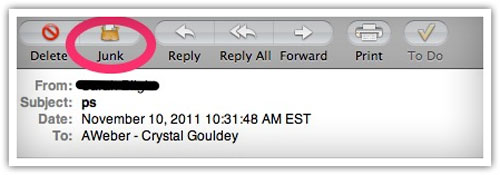Top 10 Causes for Spam Complaints

At AWeber, we want to provide the best service possible. We want you to have the best deliverability possible; the best performance. In a nutshell: complete satisfaction.
Our Best Practices Manager, Kristie Sullivan, helps us help you meet these goals. Kristie helps customers maintain their accounts by providing tips for proper list management. Part of this job entails helping manage spam complaints.
This means she’s our go-to person for learning what causes spam complaints, which bring down your deliverability, and what you can do to fix the situation. She identified the top ten reasons why spam complaints occur.
First, What’s a Spam Complaint?
When someone marks a message as spam, their email client uses a feedback loop to tell us a complaint was made. Here’s how the “mark as spam” buttons look in different email clients:
Mac mail:

Yahoo:

Gmail:

The Causes and Their Solutions
1. Lack of expectations being set
Subscribers aren’t clear on what they signed up for and when they’ll be getting emails.
Solution: Provide details in the web form, confirmation message and welcome message that let subscribers know what’s going on and what they need to do (confirm, check email certain days, etc.)2. Unrequested content
If subscribers get information they did not request, that’s spam.
Sending information regarding related products or content can fall
under this category. For example, if someone signs up for cooking
recipes, they should not get sent offers for cooking supplies, because
they did not request offers about cooking supplies.
Solution: If you’re unsure about the content you’re
sending, don’t send it! If you run multiple lists, make sure only the
list that requested that information gets it, instead of every list you
have. 3. No confirmation message
When subscribers don’t confirm, there is no audit trail. There is also more of a risk that they aren’t as interested about the information being sent.
Solution: This one’s pretty easy: turn on confirmed opt in! Don’t forget to customize the confirmation message so it sets expectations for your email campaign. 4. Invalid from address
Subscribers won’t be able to reply with any questions or concerns they have if the from address is invalid. This can be frustrating, and lead to complaints.
Solution: Invite communication. Don’t stop at using a
good from address; invite subscribers to give you feedback and contact
you on social media. People like talking to people, not businesses. If
you ever need to change your from line, make sure you let your subscribers know. 5. Lack of company branding
If the from name and address are there, but
not related to the domain the subscriber came from, the subscriber might
not recognize it. If they can’t recognize it, they may think it’s spam.
Solution: Stay consistent with your branding.
Make sure the name on your website matches the name in the from line,
include the same logo in all of your messages and use the same
signature. 6. Poor traffic source
Purchased traffic can produce bogus results.
These visitors aren’t necessarily arriving at your site because they’re
interested in you. These subscribers can forget who you are or what
they signed up for by the time they get an email from you in their
inbox.
Solution: Bring in your own traffic. Use social media to spread the word about your business, write guest posts and talk in forums on other sites in your industry and practice good search engine optimization.7. Misleading subject lines
It’s good to have a catchy subject line,
but leave out the lies, please. This means don’t put “Re:” in front of
the subject to trick subscribers, don’t reference anything irrelevant
and don’t talk about enclosed account information if there’s really no
account involved.
Solution: There are plenty of ways to present the topic of an email in an interesting way:- Offer to teach something
- Ask a question
- Announce something new
- Offer a solution to a problem
8. Hiding the unsubscribe link
If there is a lot of blank space between the
end of the content and the link to unsubscribe, it’s harder to
unsubscribe for subscribers that want to leave. If they can’t find the
unsubscribe link, they may mark the message as spam since that will
solve the problem.
Solution: Include an extra unsubscribe link in your pre-header.
The pre-header is good for including links to view online versions and
also provides the subscriber with easy access to their preferences. 9. Sending too much or too little
Even if the emails are what subscribers
requested, sending too many emails (multiple times per week) can lead to
spam complaints. On the flip side, sending not enough may cause
subscribers to forget why they’re getting these emails.
Solution: This goes back to setting expectations.
Somewhere in the expectations, mention how often they should expect to
get emails. Stay consistent with send times. 10. Poor list maintenance
Sending emails to subscribers who have been
inactive on the list for a long time is risky and not cost effective. If
the subscriber hasn’t opened an email in months, they’re probably not
interested anymore and more likely to complain.
Solution: There are a couple solutions for this.
Subscribers that haven’t opened in a couple months (or whatever length
of time you feel is appropriate) can be deleted from your list. If you don’t want to delete any subscribers right off the bat, try sending a reengagement series to get their attention.
ReplyDeleteHello,
we provide affordable and result-oriented SEO services, please give a chance to serve you.
Thanks
Admin: E07.net